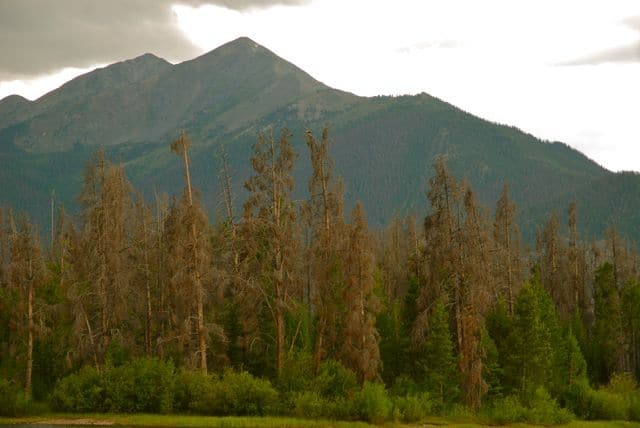This story is from the NY Times/Greenwire. It’s well thought out and touches on some topics that other news stories did not.
Here are a couple of quotes:
Forest Service officials say they want the rule to provide flexibility to account for varying local conditions. What is best for a forest in Alaska, for example, is likely to be different from what is needed in a Florida forest. They also want to make sure the new rule is simple enough that it can be easily implemented. One of the complaints from forest managers about the 1982 rule is that it was too complex, and the planning process takes too long as a result.
But Francis says simplicity should not come at the expense of effectiveness.
“It could be complicated, because we’re heading into somewhat unchartered waters, and we don’t know how climate change is going to affect things,” he said. “So you need the transparency and the accountability that we’re going to move in those directions [put forth in the rule]. That’s what the forest needs. Just because it’s hard and will require some tough decisions doesn’t mean we shouldn’t do it.”
and this..
Karen Hardigg, forest program manager for the Wilderness Society in Alaska, said if Tongass managers incorporate the new planning rule’s objectives into the forest’s management plan, it could help accelerate a shift away from old-growth logging to a more restoration-based economy.
“The emphasis on restoration and resiliency, on climate change, on collaboration — getting to shared priority-setting and preventing conflict — that could all be especially beneficial in southeast Alaska,” she said.
But like Francis, Hardigg believes the new rule leaves too much up to local forest managers. “We would have liked to have seen more solid direction. A little more teeth,” she said.
and
Its protections for wildlife are pretty weak,” said Jane Danowitz, public lands director for the Pew Environment Group. “There are some good aspects to the rule, but when it comes to a couple of key protections [for] wildlife and watersheds, they’re not strong and they tend to be left up to the discretion” of local forest managers, she added.
Michael Francis, national forest program director for the Wilderness Society says the new rule has a lot of good provisions, although he finds it long on vision but short on direction.
I wish the author of the piece has pressed those quoted to be more specific about what they wanted that they didn’t get. Those of us who are outside those “inside the Beltway” discussions would like to know. Is it as simple as “viability should be for all vertebrate species, and we don’t think the requirement for “maintaining or restoring ecosystem composition, structure and function” covers it because ____________”(fill in the blanks)?. Or do they actually want national standards of some kind?
Just as I was considering this, I found this story from the Courthouse News Service that indeed had more specifics.
“The administration appears to be looking to do the bare minimum for wildlife,” Defenders of Wildlife president Rodger Schlickeisen said in a statement.
The group, which was party to the lawsuits resulting in the California rulings, wanted the species viability standard reinstated and clear requirements for species monitoring.
Instead, the new rule eliminates use of management indicator species, and failed to include the species viability standard.
Earthjustice criticized the rule for lacking specific guidelines to protect streams and watersheds.
Environmentalists across the board say the rule gives agency managers too much leeway.
Marc Fink, senior attorney with the Center for Biological Diversity – also a party in both California lawsuits – said the new plan eschews the viability requirement for a longer process in which forest supervisors determine species of concern.
Fink added that a new pre-decision objection process reduces public involvement and is step in the wrong direction.
“We’re concerned it would leave too much discretion to the forest service,” Fink said in an interview.
Fink thinks the Obama administration simply did not make the forest plan a priority, and instead of clamping down to assure specific protections, gave way for the agency to seek greater autonomy.
The Forest Service said the new plan’s flexible processes should reduce litigation. “We want to spend less time in the courts and more time in the forests,” Agriculture Secretary Tom Vilsack said at a press conference.
The Associated Press reported that lawsuits to protect habitat for threatened and endangered species in past decades have slashed logging in National Forests by three-quarters from its peak.
But it’s false to assert that environmental litigation against logging projects is tying up taxpayer resources, Fink said.
“The data just doesn’t back them up,” Fink said, adding that only a small percentage of projects are litigated.
A Government Accountability Office report in 2010 found that only 2 percent of Forest Service fuel-reduction decisions end up in court. They are called “fuel-reduction” projects because their ostensible purpose is to reduce the threat of catastrophic wildfire.
But many environmentalists view that as a cover. They point out that if fuel reduction were truly the purpose, the projects would focus on brush and small trees, and not on mature trees that are valuable as timber.
Problems with the projects justified the challenges, Fink said, adding that legal victories have proven that the Forest Service historically abused its discretion.
“We need these meaningful sideboards and constraints so the public can act as watchdogs,” Fink said.
Although the Forest Service’s plan also emphasizes multiple uses, including recreation and resource use, preservation is intended to be its core.
“The heart of this planning rule is the requirement that we maintain and restore our forests,” USDA Undersecretary Harris Sherman said at the press conference.
There are plenty of good intentions in the regulations, Fink said, including a mention of climate change for the first time.
“But when you chip away the nice-sounding language, get to the shalls and shall nots, there’s not much left,” Fink said.
The public comment period for the plan ends in May; a final rule is expected around the end of the year.
If the Forest Service does not improve its draft rule, a legal challenge is “highly likely,” Fink said.
I guess as I go to my next litigation phone call, I’ll have to remember that my and my colleagues’ time (plus OGC, plus DOJ, plus the folks on the forest preparing the record) must not be defined as “taxpayer resources” because the GAO found that lawsuits are only filed on a small percentage of all projects.
Also, who knew that objections “reduced public involvement.” It seems like they increase public involvement because you end up talking to the objectors as well as others. What kind of “public involvement” is sending an appeal to DC for review, compared to sitting with the decisionmaker, their boss, and members of the public who are interested, to describe your concerns?
Also, the way to win friends and influence people is generally not considered to be threatening lawsuits if you don’t get your way. Just sayin’




